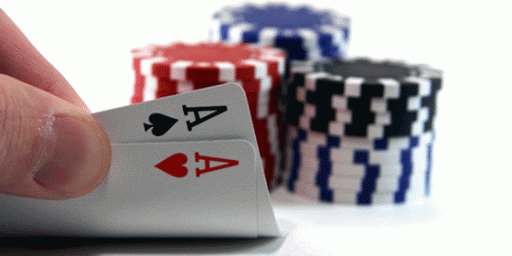World Series Of Poker
ESPN hosts the World Series Of Poker, whose popularity rather escapes me. But popular it is:
2004 World Series of Poker News
ESPN AND THE 2004 WORLD SERIES OF POKER EXPANDED COVERAGE OF NATION’S TOP POKER EVENT; 22 EPISODES STARTING JULY 6 In the second year of a multi-year contract with Harrah’s Hotel and Casino, ESPN will present an expanded schedule of the nation’s premier poker event, the 2004 World Series of Poker. Beginning July 6 at 9 p.m. ET, ESPN will air two new one-hour episodes back-to-back on Tuesdays throughout the summer (9 -11 p.m.) for a total of 22 hours of coverage.Produced under the ESPN Original Entertainment (EOE) banner, ESPN will more than triple its coverage of the event from a year ago. ESPN’s telecasts will capture the breadth of the 33-day event with the first 13 episodes dedicated to coverage of satellite tournaments that feature a variety of poker disciplines. Highlights include the finals of six tournaments, including Seven-Card Stud, Pot Limit Omaha and No Limit Hold ‘Em, and the world championship of seven events, including Ladies No Limit Hold ‘Em, Pot Limit Hold ‘Em and Razz. The last nine episodes will focus on the tournament’s main event, the Final Table of the popular No Limit Texas Hold ‘Em that will culminate with the winner being named World Champion and claiming an estimated $4 million purse. Commentators Norman Chad and Lon McEachern will return to call the action and provide complete analysis of the players and games.
While the event has only recently garnered widespread publicity, it has been around for some time:
World Series of Poker History
Though the World Series of Poker made its official debut in 1970, the idea of the Horseshoe’s annual tournament was actually conceived more than two decades earlier.In the summer of 1949, as the story goes, inveterate gambler Nicholas “Nick the Greek” Dandolos approached Benny Binion with an unusual request – to challenge the best in a high-stakes poker marathon. Binion agreed to set up a match between Dandolos and the legendary Johnny Moss, with the stipulation that the game would be played in public view.
During the course of the marathon, which lasted five months with breaks only for sleep, the two men played every form of poker imaginable. Moss ultimately won “the biggest game in town” and an estimated $2 million. When the Greek lost his last pot, he arose from his chair, bowed slightly, and uttered the now-famous words, “Mr. Moss, I have to let you go.” Dandolos then went upstairs to bed.
Though significant in its own way as a chapter in poker history, the five-month marathon took on added importance to Benny Binion. He noted that the public had gathered outside the casino each day to watch the game with the fervor of dedicated sports fans, and he was amazed at the attention the event had attracted. But it wasn’t until 1970 that Binion decided to re-create this excitement and stage a battle of poker giants – dubbed the “World Series Of Poker” – to determine who would be worthy of the title “World Champion.” Some of the best players in the country were assembled, and Johnny Moss came out on top. The decision was democratic in that the champion was decided by popular vote.
The following year, the winner was determined by a freezeout competition, with players being systematically eliminated until one player had all the chips. Moss again was declared the World Champion. In 1972, when Thomas “Amarillo Slim” Preston won the title and went on the talk-show circuit, the WSOP began to gain a wider following.
It was only a year later that Binion participated in the Oral History Project at the University of Nevada-Reno and discussed the World Series with interviewer Mary Ellen Glass. “This poker game here gets us a lot of attention,” he told Glass. “We had seven players last year, and this year we had 13. I look to have better than 20 next year. It’s even liable to get up to be 50, might get up to be more than that.” Binion then paused, and as if gazing into the future, prophesied, “It will eventually.”
In the early 1980s, with the introduction of preliminary satellite competitions with lower buy-ins, Binion’s prophesy came to fruition and the popularity of the World Series of Poker soared. But even Benny Binion, who passed away on Christmas Day of 1989, would have had difficulty foreseeing the enormous growth the Horseshoe’s annual tournament has experienced in the past decade or so.
In 1982, nine years after Mr. Binion participated in UNR’s Oral History Project, the tournament drew 52 entrants. Five years later, there were 2,141 participants, and the 2002 event attracted 7,595 entries. The prize money has increased proportionately, from $7,769,000 a decade ago to a staggering $19,599,230 in 2002. Whereas only 12 events, mostly Texas hold’em and seven-card stud, were scheduled as recently as 1988, the 2004 tournament offers 33 competitions that feature a wide variety of games.
Today, the legacy Benny Binion left the poker community ranks as the oldest, largest, most prestigious, and most media-hyped gaming competition in the world, and no doubt it holds the promise of an even brighter future. But equally important, The World Series of Poker has touched thousands of lives over the years, affording talented players the opportunity to follow their dreams, reach for the stars, and perhaps one day achieve greatness in their chosen endeavor.
I’ve played the game before, of course, but there are variants I’ve never heard of:
World Series of Poker Rules
HOLD ‘EMEACH PLAYER IS FIRST DEALT TWO CARDS DOWN.
A ROUND OF BETTING OCCURS AS PLAYERS DECIDE FOR THE FIRST TIME IF THEY ARE IN OR THEY’RE OUT.
THEN FIVE COMMUNITY CARDS FOLLOW WITH BETTING AFTER THE FLOP, THE TURN, AND THE RIVER.
IN THE END, THE BEST FIVE CARD COMBINATION WINS THE HAND AND TAKES THE POT.
OMAHA
THE GAMES IS PRETTY MUCH THE SAME AS TEXAS HOLD ‘EM. EXCEPT FOR ONE BIG DIFFERENCE.
INSTEAD OF BEING DEALT TWO CARDS, EACH PLAYER RECIVES FOUR DOWN CARDS.
A ROUND OF BETTING OCCURS AS PLAYERS DECIDE FOR THE FIRST TIME IF THEY ARE IN OR THEY’RE OUT.
THEN FIVE COMMUNITY CARDS FOLLOW WITH BETTING AFTER THE FLOP, THE TURN, AND THE RIVER.
THOSE STILL IN REVEAL THEIR CARDS. BUT HERE’S THE CATCH… A PLAYER MUST USE TWO AND ONLY TWO OF THEIR DOWN CARDS ALONG WITH THREE OF THE COMMUNITY CARDS. AND AS AWLAYS, THE BEST FIVE CARD HAND WINS THE POT.
SEVEN CARD STUD
EACH PLAYER IS DEALT THREE CARDS. THE FIRST TWO ARE DOWN AND THE THIRD IS UP FOR EVERYONE TO SEE.
PLAYERS MUST THEN DECIDE FOR THE FIRST TIME WHETHER THEY’RE IN, OR OUT.
THE NEXT THREE CARDS ARE ALL DEALT FACE UP, WITH MORE ROUNDS OF BETTING AFTER EACH CARD.
THE SEVENTH AND FINAL CARD IS DEALT FACE DOWN.
AFTER ONE LAST ROUND OF BETTING, PLAYERS STILL IN WILL REVEAL WHAT THEY HAVE. AS ALWAYS, THE BEST FIVE CARD HAND WINS THE HAND AND TAKES THE POT.
RAZZ
THIS GAME IS A LOT LIKE SEVEN CARD STUD…EXCEPT OF COURSE THE LOW HAND WINS.
TO BEGIN, THREE CARDS ARE DEALT TO EACH PLAYER.
THE FIRST TWO ARE DOWN CARDS, THE THIRD IS UP FOR EVERYONE TO SEE.
A ROUND OF BETTING FOLLOWS, AS IT DOES AFTER EACH OF THE NEXT THREE UP CARDS ARE DEALT.
THE SEVENTH AND LAST CARD IS DEALT FACE DOWN.
ONE MORE ROUND OF BETTING BEFORE PLAYERS STILL IN WILL REVEAL WHAT THEY HAVE.
NOW REMEMBER THE LOW HAND IS THE WINNER AND FLUSHES AND STRAIGHTS DON’T COUNT AS HIGH HANDS SO ACE TO FIVE IS A GOOD AS IT GETS.
LOWBALL
BASICALLY, IT’S FIVE CARD DRAW AND THE LOW HAND WINS
THE POINT OF THE GAME IS TO HAVE THE LOWEST HAND POSSIBLE.
BUT UNLIKE RAZZ, STRAIGHTS AND FLUSHES COUNT AS HIGH HANDS.
SO THE BEST POSSIBLE HAND A PLAYER COULD HAVE IS 2, 3, 4, 5, AND 7.
EACH PLAYER RECEIVES FIVE CARDS FACE DOWN.
AFTER A ROUND OF BETTING A PLAYER IS ALLOWED TO DRAW UP TO FIVE NEW CARDS.
ONCE A PLAYER RECEIVES THEIR NEW CARDS, A FINAL ROUND OF BETTING FOLLOWS.
PLAYERS THEN REVEAL THEIR CARDS AND SINCE THE LOWEST HAND IS THE BEST-2,3,4,5 AND 7 OFF SUIT IS AS GOOD AS IT GETS.
ESPN provides the following glossary of terms:
Poker Glossary
ACTION n. Money that is being bet. “No action” means a hand or game has few bettors and fewer raisers. “Gimme some action” is ostensibly a plea for calls and raises.
ALL-IN adj. To have all of one’s chips in the pot. A player who is all-in cannot be forced out of the pot by more betting, but is only eligible to win that portion of the pot he has contributed to. Generally, a SIDE POT is created each time a player is all-in.
ANTE n. A small bet all players are required to make before a hand is dealt. Not all games have an ante. Related terms: BLIND, FORCED BET.
BLIND n. A mandatory bet made by certain player(s) usually sitting left of the BUTTON before each new hand is dealt. Used in place of antes or in conjunction with antes.
BUY-IN n. The minimum amount of money necessary to join a game. Also, the amount of money one actually used to join the game. See also: REBUY.
BUY IN v.i. To purchase chips at the start of a game. Thus in a game with a $100 buy-in one might buy in for $147.
CALL v.t. To put in to the pot the minimum amount of money necessary to continue playing.
CHECK v.i. To bet zero, when it is legal to do so. Frequently a sign of only a fair hand, but may be a bluff.
CHECK RAISE v. To check initially, then raise a bet made later on in the same betting round. Frequently a sign of strength, but may be a bluff.
COMMUNITY CARDS n. Cards that are available for every player to use in making a hand. Usually dealt face up somewhere in the middle of the table.
COLD CALL n. Calling both a bet and raise at the same time, as opposed to calling a bet then later calling a raise made after the call.
DEAD MONEY n. Money contributed to the pot by players who have folded.
DOYLE BRUNSON n. In Hold’em, 10-2 in the hole. So named because Doyle Brunson won two straight WSOPs (q.v.) in 1975 and 1976 with 10-2 on the last hand. (Suited (spades) in 1975, unsuited in 1976).
DRAW OUT v.i. To catch a card that improves your situation from a losing hand to a winning hand, especially when you beat someone holding a hand that usually figures to win.
EVEN-MONEY adj. A bet that pays off exactly the amount wagered. E.g., “Double or nothing” is an even-money bet.
FISH n. A player who loses money. An old saying is “If you can’t spot the fish at the table, *you* are the fish.”
FLOP n. In Hold’em, the first three community cards, dealt simultaneously.
FLAT CALL v.t. To call a bet. Emphasizes that the caller did not raise.
FLUSH n. A poker hand consisting of five cards all one suit.
FOUR FLUSH n. Four cards to a flush.
FOUR OF A KIND n. A hand containing all four cards of the same rank.
FREEZE-OUT n. A table-stakes game that continues until a small number of players (possibly only one) has all the money. The major event in The World Series of Poker is a freeze-out game.
FULL HOUSE n. A hand consisting of 3-of-a-kind and a (different) pair.
GIVING AWAY v.t. Revealing one’s hand by obvious play.
HEADS UP adj. Playing a single opponent.
HIT n. To make a hand or catch a card or cards that improves one’s hand. “I hit a gut-shot draw on the river.”
HOLD’EM n. [1] Generic name for a class of poker games where the players receive a certain number (2 to 4) of hole cards and 5 community cards. Usually there are betting rounds after dealing the hole cards, then after dealing 3 upcards (FLOP), after dealing a 4th upcard (TURN) and finally after dealing a 5th upcard (RIVER).
HOLE CARDS n. In stud and Hold’em, the face-down cards dealt to each player.
INSIDE STRAIGHT n. Four cards to a straight, where only one rank will complete the hand. E.g., 4-5-6-8 is an inside straight since only a 7 will fill (i.e., complete) the hand. Often called a GUT-SHOT.
LATE BLIND n. In addition to “regular” blinds, some games allow a player (particularly a new one) to post a blind bet in return for the right to enter the game immediately and act last on the first betting round. The amount of the blind is determined by house rules, usually somewhere between the last blind and double the last blind. It is frequently a LIVE BLIND.
LITTLE SLICK n. In Hold’em, hole cards of A-2, suited or not.
MAIN POT n. The main pot, as related to one or more side pots, when there are one or more all-in player(s). The main pot is the one in which all active players participate.
MUCK n. A collection of face-down cards near the dealer composed of discards, i.e., folded hands, burns and discards for drawing purposes.
NO-LIMIT POKER n. A game where there is no maximum bet; a player can wager any amount (perhaps above some minimum) up to whatever money is on the table in front of him.
NUT adj. The best possible hand of a given class. The “nut flush” is the highest possible flush, but might still lose to, e.g., a full house. Usually used in Hold’em games.
OMAHA n. A variant of Hold’em where each player receives 4 hole cards and must use exactly two of them (together with 3 of 5 board cards) to make a hand. Often played high-low split with an 8 qualifier for low.
ON THE COME adj. A situation where the player does not have a complete hand but hopes to make one if the right cards come up.
OPEN-ENDED STRAIGHT n. Four cards to a straight which can be completed by drawing a card at either end. E.g., 6-7-8-9 is an open-ended straight.
OPEN-HANDED n. A category of games characterized by a part of each player’s hand being exposed.
OVERPAIR n. In Hold’em, a pair in the hole that is larger than any community card on the board.
PAIR n. Two cards of the same rank.
PASS v.i. Opposite of bet. To check, if checked to. To fold, if bet to.
POCKET [CARDS] n. Hole cards in stud and Hold’em.
POCKET ROCKETS n. In Hold’em, a pair of aces for hole cards.
POCKET PAIR n. Generic Hold’em term for 2 hole cards of the same rank.
QUADS n. Four of a kind.
RAINBOW adj. In flop games, a flop in which no two cards are of the same suit. “The flop was A 9 7 rainbow.”
RAISE v.t. To wager more than the minimum required to call, forcing other players to put in more money as well.
ROYAL FLUSH n. An ace-high straight flush, the best possible hand in regular poker.
RUSH n. A winning streak. Also “ON A RUSH”.
SANDBAG v.i. Playing a strong hand as if it were only a fair one.
SEE v.t. To call, as in: “I’ll see you” or “I’ll see that bet”.
SHORT-STACKED adv. Playing with a only a small amount of money, thus limiting one’s risk and reward.
SMALL BLIND n. In games with two blinds the first blind is the SMALL BLIND because it is usually one-half (or less) the second or large blind.
STAND OFF v.i. To call a raise. “Opener raises, I stand off.”
STRAIGHT n. A hand consisting of 5 cards in sequence but not in suit.
STRAIGHT FLUSH n. A hand consisting of 5 cards in sequence and the same suit.
TABLE STAKES n. A standard rule whereby during a hand players can only bet the money they have on the table. If the bet to a player is more than the player’s stack, that player may call with all his chips and be eligible to win only that portion of the pot he contributed to equally. A side pot is created, for which only the remaining players may compete.
THREE OF A KIND n. Three cards all the same rank.
TRIPS n. Three of a kind. In Hold’em the term SET is used when two of the three cards are hole cards.
TURN n. The fourth community card in Hold’em.
TWO FLUSH n. Two suited cards.
UNDER THE GUN n. The position that has to act first in a round of betting.
UP adj. Designates the higher card of a hand consisting of two pair. Thus, “Queens up” refers to two pair, of which the higher pair is queens and the lower pair is unspecified. See also OVER.
WALK n. A pot won by the last blind when no one opens.
(Glossary of Poker terms v2.0 31-Mar-1995 Copyright (C) 1993, 1995, John C. Hallyburton, Jr. Copying for noncommercial use is permitted provided all copies carry this copyright.)
Update: If there’s a reason to watch poker on television, this might be it: All In magazine has a pictorial of Shana Hiatt.






For a list of all winners since 1970, see: World Series of Poker Champions – WSOP Winners 1970-2004





